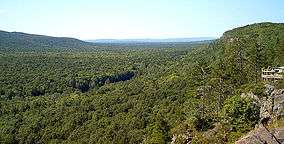Porcupine Mountains
| Porcupine Mountains Wilderness State Park | |
|---|---|
|
A vista in the Porcupine Mountains | |
 Location within the state of Michigan | |
| Location | Ontonagon / Gogebic counties, Michigan, United States |
| Nearest city | Ontonagon, Michigan |
| Coordinates | 46°46′N 89°45′W / 46.767°N 89.750°WCoordinates: 46°46′N 89°45′W / 46.767°N 89.750°W |
| Area | 59,020 acres (23,880 ha) |
| Established | 1945 |
| Governing body | Michigan Department of Natural Resources |
| http://www.dnr.state.mi.us/parksandtrails/details.aspx?id=426&type=SPRK | |
| Designated | 1984 |
The Porcupine Mountains, or Porkies, are a group of small mountains spanning the northwestern Upper Peninsula of Michigan in Ontonagon and Gogebic counties, near the shore of Lake Superior. The area is part of the Porcupine Mountains Wilderness State Park. The Porcupine Mountains were named by the native Ojibwa people, supposedly because their silhouette had the shape of a porcupine.[1]
History
The Porcupine Mountains were the site of copper mining in the 19th century. One of these mines is the Nonesuch Mine, which operated sporadically from 1867 to 1912. The Porkies are also the location of a large stand of old growth forest, and home to many black bears. The area is popular among tourists, especially the Lake of the Clouds in the heart of the mountains. There have been numerous bear sightings.
Geology
The most striking geological feature of the Porcupine Mountains is the long basalt and conglomerate escarpment parallel to the Lake Superior shore and overlooking Lake of the Clouds, a continuation of the same copper-bearing bedrock found farther northeast on the Keweenaw Peninsula. A second ridge farther inland, on the other side of Lake of the Clouds, includes Summit Peak, the highest point in the mountains at 1,958 feet (595 m).[2] Rivers, waterfalls, swamps, and lakes lie between the rocky outcroppings. There are a number of waterfalls on the Presque Isle River in the extreme western side of the park.
The mountains are subject to heavy lake-effect snow from Lake Superior. The relatively high elevation of the mountains and their proximity to the lake provide perfect conditions for lake-effect snow, but no official records are maintained anywhere in the mountains. The closest National Weather Service station is in the coastal community of Ontonagon, where the annual average is about 200 inches (510 cm). Totals of well over 250 inches (640 cm) annually are likely in the higher elevations. It is not uncommon to have 300-inch (760 cm) seasons in this region.

Porcupine Mountains Wilderness State Park
The Porcupine Mountains are home to the most extensive stand of old growth northern hardwood forest in North America west of the Adirondack Mountains, spanning at least 31,000 acres (13,000 ha). In these virgin forests, sugar maple, American basswood, eastern hemlock, and yellow birch are the most abundant tree species.[3]
Porcupine Mountains State Park was established in 1945 to protect this large stand of old-growth forest, much of "maple-hemlock"type. In 1972, Michigan passed the Wilderness and Natural Areas Act. This act gave the park the new designation of the Porcupine Mountains Wilderness State Park. The facilities provided by the park include an extensive network of backcountry trails for hiking and wilderness backpacking, rustic trailside cabins, modern campgrounds, swimming and boating areas, and various interpretive programs led by park rangers. The North Country Trail passes through the park, making up a portion of the 87 miles (140 km) of hiking trails. In the winter, a ski area also operates within the park. Because of the copper mining history of the park, it is a cooperating unit of Keweenaw National Historical Park.
Fauna in the park includes moose, gray wolves, white-tailed deer, coyotes, gray and red foxes, river otters, beaver, fisher, marten, mink, bobcats, lynx, black bears, and porcupines.
See also
- Porcupine Mountains Music Festival
References
- ↑ Vogel, Virgil J. (1986). Indian Place Names in Michigan, pp. 106-07. University of Michigan Press. ISBN 0-472-06365-0.
- ↑ http://porcupinemountains.com/itineraries/porcupine-mountains-hiking-vacation/
- ↑ Mary Byrd Davis (23 January 2008). "Old Growth in the East: A Survey". Archived from the original on 17 February 2012. Retrieved 27 August 2013.
External links
| Wikimedia Commons has media related to Porcupine Mountains. |
| Wikivoyage has a travel guide for Porcupine Mountains. |
- Porcupine Mountain Wilderness State Park Michigan Department of Natural Resources
- Porcupine Mountains State Park Protected Planet (World Database on Protected Areas)
